

Minimal Surfaces. Útiles Geometría. Rectas, circunferencias y ángulos. Sistema de Coordenadas Cartesianas. Transformaciones geométricas. Cuerpos geométricos. Figuras Planas. Regularidades y simetrías. Dibujo. Flower of Life. This mystical symbol can be found in almost all major religions in the entire world.
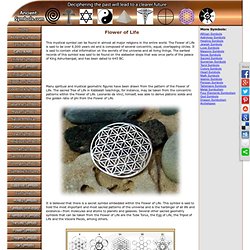
The Flower of Life is said to be over 6,000 years old and is composed of several concentric, equal, overlapping circles. It is said to contain vital information on the secrets of the universe and all living things. The earliest records of this symbol was said to be found on the alabaster steps that was once parts of the palace of King Ashurbanipal, and has been dated to 645 BC. Tetractys. Sacred Geometry; The Flower of Life. Introduction Sacred geometry may be understood as a worldview of pattern recognition, a complex system of hallowed attribution and signification that may subsume religious and cultural values to the fundamental structures and relationships of such complexes as space, time and form.
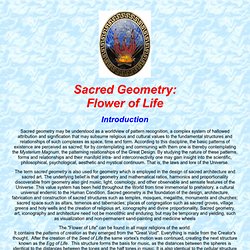
According to this discipline, the basic patterns of existence are perceived as sacred: for by contemplating and communing with them one is thereby contemplating the Mysterium Magnum, the patterning relationships of the Great Design. By studying the nature of these patterns, forms and relationships and their manifold intra- and interconnectivity one may gain insight into the scientific, philosophical, psychological, aesthetic and mystical continuum. That is, the laws and lore of the Universe. The term sacred geometry is also used for geometry which is employed in the design of sacred architecture and sacred art. Leonardo da Vinci has studied the Flower of Life's form and its mathematical properties. 1. 2. 3. Departamento de Geometría y Topología. Riemann sphere. The Riemann sphere can be visualized as the complex number plane wrapped around a sphere (by some form of stereographic projection – details are given below).
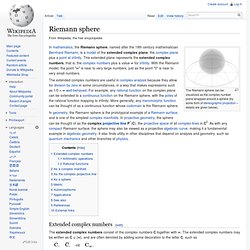
The Scientific Graphics Project. Sacred Geometry: Flower of Life. Sacred Geometry - Flower of Life By Andrew Monkman I believe the complete ancient flower of life is an inter-dimensional tool, a portal, a stargate, a window into what some call the inter space plains.

The original flower of life (found on several pillars within "the Osireion" at abydos in Egypt) is incomplete, because it is only the first layer of three (pic1+2). 1. Flower of Life carved on a temple wall. Pentagram. A pentagram inscribed in a circle, also known as a pentacle A pentagram (sometimes known as a pentalpha or pentangle or a star pentagon) is the shape of a five-pointed star drawn with five straight strokes.
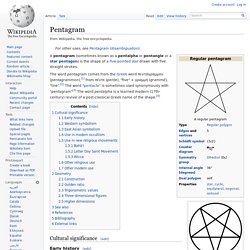
The word pentagram comes from the Greek word πεντάγραμμον (pentagrammon),[1] from πέντε (pente), "five" + γραμμή (grammē), "line".[2] The word "pentacle" is sometimes used synonymously with "pentagram"[3] The word pentalpha is a learned modern (17th-century) revival of a post-classical Greek name of the shape.[4] Cultural significance[edit] Early history[edit] In early (Ur I) monumental Sumerian script, a pentagram glyph served as a logogram for the word ub, meaning "corner, angle, nook; a small room, cavity, hole; pitfall" (this later gave rise to the cuneiform sign UB 𒌒, composed of five wedges, further reduced to four in Assyrian cuneiform ).
Golden ratio. Line segments in the golden ratio In mathematics, two quantities are in the golden ratio if their ratio is the same as the ratio of their sum to the larger of the two quantities.
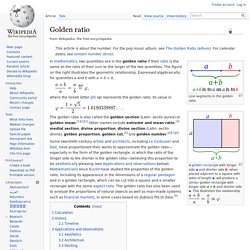
The figure on the right illustrates the geometric relationship. Expressed algebraically, for quantities a and b with a > b > 0, The golden ratio is also called the golden section (Latin: sectio aurea) or golden mean.[1][2][3] Other names include extreme and mean ratio,[4] medial section, divine proportion, divine section (Latin: sectio divina), golden proportion, golden cut,[5] and golden number.[6][7][8] Some twentieth-century artists and architects, including Le Corbusier and Dalí, have proportioned their works to approximate the golden ratio—especially in the form of the golden rectangle, in which the ratio of the longer side to the shorter is the golden ratio—believing this proportion to be aesthetically pleasing (see Applications and observations below).
Calculation Therefore, Multiplying by φ gives.